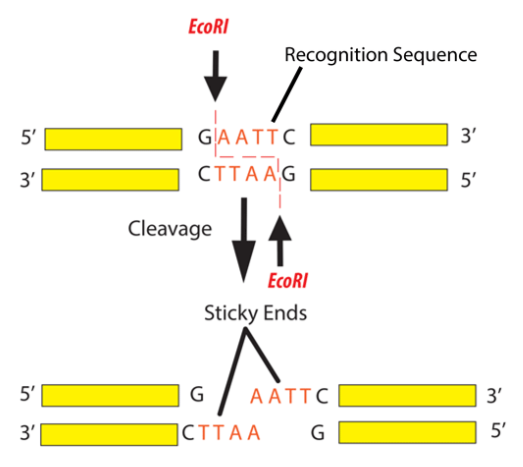
Answer
459.6k+ views
Hint: The recognition sequence of nucleic acid where the enzyme cuts are G/AATTC, which has a complementary and palindromic sequence of CTTAA/G. Restriction endonuclease is also called the restriction enzyme. It cuts double helix DNA in a precise way.
Complete answer:
The species from which the restriction endonuclease enzyme, EcoR I, originated will state the end part of that enzyme.
Whereas the letter R is the representation of certain strains in this case it is RY13.
Figure – 2: structure of EcoRI

From the species E. coli, EcoR I is a restriction endonuclease enzyme that is isolated.
The number I which is the last part of its name, is the one which denotes that EcoR I was the first enzyme which is isolated from this straining.
The only restriction enzyme which cleaves the DNA double helices into fragments at precise positions is the EcoRI.
EcoRI is a restriction endonuclease enzyme which is also a part of the restriction-modification system.
The EcoR I is the endonuclease enzyme which is used as a restriction enzyme in molecular biology. EcoR I generate 4 nucleotide tacky split ends with 5' end ledges of AATT.
So, the correct option is 'EcoR I'.
Additional Information:
- A restriction enzyme (which is also called restriction endonuclease, or restrictive) can be termed as an enzyme that cleaves the complete DNA into fragments by the side of definite recognition locations within molecules known as restriction sites. The restriction enzymes are one class of the wider endonuclease group of enzymes.
- Hind III cleaves DNA at a particular site.
- The recurrent neural network that was introduced by Bart Kosko in 1988 is known as BAM (Bidirectional associative memory).
- The restriction enzyme that is of prokaryotic type of DNA and protects organisms from unknown, foreign DNA is called Hae III.
Note: In the above statements, the / in the classification designates the phosphodiester bond in the enzyme will disrupt the DNA particle. GAATTC is a palindromic sequence and can be defined as a sequence of the nucleic acid in a DNA or RNA molecule which is stranded double in which reading is in a firm direction.
Complete answer:
The species from which the restriction endonuclease enzyme, EcoR I, originated will state the end part of that enzyme.
Whereas the letter R is the representation of certain strains in this case it is RY13.
Figure – 2: structure of EcoRI

From the species E. coli, EcoR I is a restriction endonuclease enzyme that is isolated.
The number I which is the last part of its name, is the one which denotes that EcoR I was the first enzyme which is isolated from this straining.
The only restriction enzyme which cleaves the DNA double helices into fragments at precise positions is the EcoRI.
EcoRI is a restriction endonuclease enzyme which is also a part of the restriction-modification system.
The EcoR I is the endonuclease enzyme which is used as a restriction enzyme in molecular biology. EcoR I generate 4 nucleotide tacky split ends with 5' end ledges of AATT.
So, the correct option is 'EcoR I'.
Additional Information:
- A restriction enzyme (which is also called restriction endonuclease, or restrictive) can be termed as an enzyme that cleaves the complete DNA into fragments by the side of definite recognition locations within molecules known as restriction sites. The restriction enzymes are one class of the wider endonuclease group of enzymes.
- Hind III cleaves DNA at a particular site.
- The recurrent neural network that was introduced by Bart Kosko in 1988 is known as BAM (Bidirectional associative memory).
- The restriction enzyme that is of prokaryotic type of DNA and protects organisms from unknown, foreign DNA is called Hae III.
Note: In the above statements, the / in the classification designates the phosphodiester bond in the enzyme will disrupt the DNA particle. GAATTC is a palindromic sequence and can be defined as a sequence of the nucleic acid in a DNA or RNA molecule which is stranded double in which reading is in a firm direction.
Recently Updated Pages
what is the correct chronological order of the following class 10 social science CBSE

Which of the following was not the actual cause for class 10 social science CBSE

Which of the following statements is not correct A class 10 social science CBSE

Which of the following leaders was not present in the class 10 social science CBSE

Garampani Sanctuary is located at A Diphu Assam B Gangtok class 10 social science CBSE

Which one of the following places is not covered by class 10 social science CBSE

Trending doubts
Which are the Top 10 Largest Countries of the World?

How do you graph the function fx 4x class 9 maths CBSE

Fill the blanks with the suitable prepositions 1 The class 9 english CBSE

The only snake that builds a nest is a Krait b King class 11 biology CBSE

The Equation xxx + 2 is Satisfied when x is Equal to Class 10 Maths

In Indian rupees 1 trillion is equal to how many c class 8 maths CBSE

Give 10 examples for herbs , shrubs , climbers , creepers

Why is there a time difference of about 5 hours between class 10 social science CBSE

Which places in India experience sunrise first and class 9 social science CBSE



